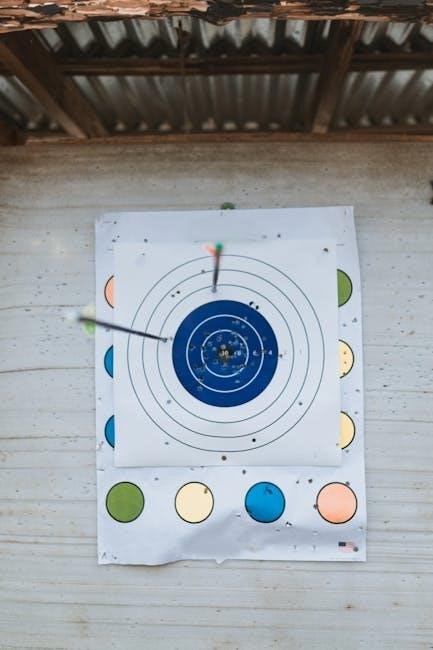Bowling Score Sheet PDF: A Comprehensive Guide
A bowling score sheet PDF is essential for tracking performance. It records player names, rolls, and scores. These sheets help determine the winner and simplify scorekeeping, whether you are casual or in a league.
Understanding the Bowling Score Sheet
A bowling score sheet is a chart-format document used to record players’ scores during bowling tournaments. It is a vital tool for tracking performance, determining the winner, and sometimes projecting scores on a digital scoreboard during the game. The score sheet includes sections for player names, individual frame scores, and total scores.
Each frame consists of boxes to record the number of pins knocked down with each roll. The sheet also provides space to calculate and record the cumulative score for each frame. Understanding how to read and interpret a bowling score sheet is essential for both casual and competitive bowlers. It is the foundation for accurate scorekeeping.

A well-designed sheet ensures that all players are scored fairly and that the game’s results are easily verifiable.
Purpose of a Bowling Score Sheet
The primary purpose of a bowling score sheet is to accurately track the performance of all participants in a bowling game. It serves as an official record of each player’s rolls, strikes, spares, and frame scores, ultimately determining the total score. The score sheet provides a structured format for recording this information, ensuring that the game’s results are easily verifiable.
Beyond tracking individual scores, the bowling score sheet facilitates fair play by providing a clear and consistent method for recording and calculating scores. This standardized approach is crucial in both casual games and competitive tournaments, where accuracy is paramount. Furthermore, the score sheet can be used for record-keeping purposes.

It allows bowlers to monitor their progress over time, identify areas for improvement, and compare their performance with others. In essence, the bowling score sheet is a fundamental tool for organizing, tracking, and analyzing bowling performance.
Key Elements of a Bowling Score Sheet
A typical bowling score sheet contains several key elements designed to effectively capture the progress of a game. The essential components include a section for player information, frame-by-frame scoring columns, and a total score calculation area. The player information section usually includes space for names and sometimes team affiliations, ensuring each bowler’s performance is clearly identified.
The frame-by-frame columns, numbered 1 through 10, are the central part of the score sheet, where individual rolls are recorded. Each frame has boxes for the first and second rolls, plus an area to calculate the frame score. These columns are designed to accommodate strikes, spares, and open frames, providing a clear visual representation of each player’s performance throughout the game.
Finally, the total score calculation area provides a space to sum up the scores from all ten frames. This section is crucial for determining the final standings and identifying the winner. These elements work together to provide a comprehensive record of the game.
Player Information Section
The player information section is a critical component of any bowling score sheet, serving as the foundation for tracking individual performance. Typically located at the top of the sheet, this area provides space to record essential details about each bowler participating in the game. At a minimum, this section includes clearly labeled fields for the player’s name, ensuring accurate identification throughout the scoring process.
In addition to names, some score sheets may include additional fields to capture more comprehensive information. These can include team names, especially in league or tournament play, allowing for easy organization and team-based scoring. The date of the game is also often recorded in this section.
Accurately completing the player information section is vital for maintaining organized and understandable records. Clear handwriting and consistent formatting help prevent confusion and ensure that the score sheet remains a reliable reference point for game results. This section sets the stage for accurate scorekeeping and facilitates easy analysis of individual and team performance.
Frame-by-Frame Scoring Columns
The heart of the bowling score sheet lies within the frame-by-frame scoring columns. These columns, typically ten in number, correspond to the ten frames in a standard game of bowling. Each column is further divided into smaller sections, designed to capture the results of each ball rolled within that frame.
The upper portion of each frame is used to record the number of pins knocked down with each ball. For example, if a bowler knocks down seven pins on their first ball, a “7” is entered into the corresponding space. If any pins remain, the result of the second ball is recorded in the adjacent space.

The lower portion of each frame is reserved for the cumulative score. This is where the running total is calculated as the game progresses, reflecting the bowler’s performance up to that point. Special notations, such as “X” for a strike and “/” for a spare, are used to indicate when bonus points are applicable. These columns provide a detailed account of each frame.
Total Score Calculation Area
The total score calculation area is the final destination on the bowling score sheet, where all the frame scores culminate into a comprehensive game total. This area, usually located at the end of the frame-by-frame columns for each player, provides a dedicated space for recording the final score achieved by the bowler.
Accurately calculating the total score is crucial, especially when strikes and spares are involved, as they require adding bonus points from subsequent rolls. The total score area typically includes a clearly labeled space to write the final number, ensuring that it is easily visible and distinguishable from the individual frame scores.

Double-checking this final calculation is vital to ensure accuracy, especially in competitive settings or when wagering is involved; Utilizing a well-designed bowling score sheet PDF can simplify this process by providing a clear and organized layout for tracking scores and adding bonus points, thereby minimizing the risk of errors and ensuring fair play. The total score area offers a concise summary of the bowler’s performance.

Using a Bowling Score Sheet PDF
Using a bowling score sheet PDF simplifies scorekeeping. Download and print for easy access. Record player names and enter scores for each frame. This ensures an organized and accurate game.
Downloading and Printing a Bowling Score Sheet PDF
Downloading and printing a bowling score sheet PDF is a straightforward process. First, locate a suitable template online. Many websites offer free, printable bowling score sheets in PDF format. Ensure the template includes sections for player names, frames, and total scores.

Once you’ve found a suitable template, download the PDF file to your computer. Open the file using a PDF reader such as Adobe Acrobat Reader. Review the document to ensure it meets your needs. Next, connect your printer to your computer and load it with paper.
In the PDF reader, select the “Print” option. Adjust the print settings as needed, such as paper size and orientation. Confirm the settings and click “Print”. The bowling score sheet PDF will now print, providing you with a ready-to-use template for tracking scores during your bowling game.
Filling Out the Bowling Score Sheet
Filling out a bowling score sheet accurately is crucial for tracking the game. Start by writing each player’s name in the designated spaces. Ensure names are legible for easy identification. Each row represents a player, and each column represents a frame.
As the game progresses, record the number of pins knocked down with each ball in the corresponding boxes. If a player bowls a strike, mark an “X” in the frame. For a spare, mark a “/” in the frame. After each frame, calculate and record the frame score.
Remember that strikes and spares require adding bonus points from subsequent rolls. Keep a running total of each player’s score in the total score column. Double-check all calculations to avoid errors. Accurate scorekeeping ensures a fair and enjoyable bowling experience for everyone involved.
Recording Player Names
The first step in using a bowling score sheet is recording the player names. This ensures clear tracking of individual scores throughout the game. Designate a specific section, usually at the top or left side of the sheet, for player names.
Write each player’s name legibly within the provided space. Ensure that the names are easily distinguishable, especially if multiple players are participating. Consider using a pen with clear ink to avoid smudging or fading. For team play, include team names alongside player names for added clarity. If the sheet allows, adding player numbers can also help with organization.
Accurate recording of player names prevents confusion and ensures that each bowler’s performance is correctly attributed. This foundational step sets the stage for accurate and fair scorekeeping throughout the entire bowling session. It also helps in maintaining records for future reference and analysis.
Entering Scores for Each Frame
After recording player names, the next crucial step is entering scores for each frame. A standard bowling game consists of ten frames, each with designated spaces for recording the results of the bowler’s throws. Accurately entering these scores is vital for determining the final outcome.
For each frame, there are typically two small boxes to record the number of pins knocked down with each ball. If a bowler knocks down all ten pins on the first ball (a strike), mark an “X” in the first box. If it takes two balls to knock down all ten pins (a spare), record the number of pins from the first ball and then mark a “/” in the second box.
When the bowler does not knock down all ten pins in either one or two balls, simply record the number of pins knocked down in each box. Be precise and legible to avoid errors in later calculations. Double-check each entry to ensure accuracy.

Tips for Accurate Scorekeeping
Accurate scorekeeping ensures fair play and reliable results. Knowing strike and spare rules is key. Always double-check calculations for accuracy. Use clear templates to organize information, ensuring all details are legible.
Understanding Strike and Spare Scoring
In bowling, strikes and spares significantly impact scoring. A strike, marked with an “X,” means all ten pins were knocked down on the first ball. For scoring, a strike is worth 10 points plus the total pins knocked down in the next two balls. This bonus makes accurate strike tracking crucial.
A spare, noted with a “/”, occurs when all ten pins are knocked down using both balls in a frame. A spare is scored as 10 points plus the number of pins knocked down with the next ball. Understanding these bonus calculations is essential for precise scorekeeping.

Failing to correctly calculate strike and spare bonuses can lead to considerable score discrepancies. Ensure each frame is reviewed, and use printable PDFs with clear sections for pins and totals to help minimize errors and ensure accurate game results.
Double-Checking Calculations

Accuracy is paramount in bowling scorekeeping; thus, double-checking calculations is critical. Errors in summing frame scores or miscalculating strike and spare bonuses can drastically alter the final results. It’s advisable to review the score sheet after each game to ensure precision.
Use a systematic approach when verifying scores. Begin by confirming the correct entry of each ball’s pin count. Next, meticulously recalculate any frames involving strikes or spares, ensuring the bonus points are added accurately. Don’t overlook simple addition errors when totaling frame scores.
Consider involving another player to help verify the calculations. A second pair of eyes can often catch mistakes that might be missed otherwise. Printable bowling score sheet PDFs with clearly defined sections for each frame and total scores can aid in this process, making error detection more straightforward. Consistent vigilance ensures fair and precise scoring.
Utilizing Templates for Clarity
Employing well-designed templates significantly enhances the clarity of bowling scorekeeping. A structured template provides designated areas for player names, frame scores, and cumulative totals, minimizing ambiguity and reducing the risk of errors. A clean and organized layout makes score tracking more efficient.
Look for templates that clearly differentiate between frames and offer adequate space for noting individual ball scores, strikes, and spares. Some templates include sections for team names and dates, which aids in record-keeping. Printable bowling score sheet PDFs offer a convenient way to access these structured layouts.
When selecting a template, prioritize ease of use and readability. Choose a design that aligns with your specific needs, whether for casual games or competitive leagues. Consistently using the same template promotes familiarity and streamlines the scoring process. By utilizing templates, scorekeepers can maintain accurate and easily understandable records.




